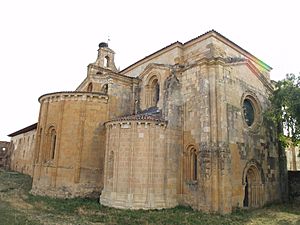Monastery of Santa María de Sandoval facts for kids

The Santa María de Sandoval was a Roman Catholic monastery in Spain. It belonged to the Cistercian Order, a group of monks. The monastery was active from the 12th century until 1835.
The oldest parts of the building were made in the Romanesque style. Later additions used the Gothic style. Today, you can find its ruins in Villaverde de Sandoval. Since 1931, it has been a special historical and artistic monument. In 2015, the Spanish government also linked it to the Camino de Santiago. This famous route is a UNESCO World Heritage Site.
Contents
How the Monastery Started
In 1142, Emperor Alfonso VII gave some land to his helper, Count Ponce de Minerva. This land was called Sotnoval or Saltus Novalis. It was located near where the Porma and Esla rivers meet. This spot was just a few miles from the city of León.
Building a New Home for Monks
In 1167, Count Ponce and his wife, Estefanía Ramírez, decided to give this land away. With their children's agreement, they gave it to Abbot Diego Martínez. He was from the monastery of Santa María de la Santa Espina. The plan was to build a brand new Cistercian monastery there.
First Monks Arrive
Monastic life at Sandoval began in 1171. Twelve monks from La Santa Espina came to live there. Abbot Diego led this first group. Sandoval started as a "daughter house" of La Santa Espina. This means it was founded by monks from the older monastery. However, Sandoval quickly became as important as its parent monastery.
Important Supporters and Gifts
Many important people helped Sandoval monastery. One early supporter was Urraca. She was the daughter of Emperor Alfonso VII. The monks held a special mass for her every year on June 25.
Land and Rights
The monastery received many gifts. These included land, like dehesas (special pastures). They also received feudal rights, which gave them power over certain areas. In 1222, King Ferdinand III gave the monastery more land and dehesas. Sandoval also had a smaller "daughter house" of its own at Valdellán.
Later Years and Abandonment
After 1487, Sandoval monastery joined a group called the Congregation of Castile. This group was made of Cistercian monasteries in Spain that had been reformed. They followed stricter rules.
The End of Monastic Life
In 1835, the monks had to leave the monastery. This happened during the first confiscation of Mendizábal. During this time, the Spanish government took control of many church properties. Even after the monks left, the building continued to be used as a local church. Services are still held there sometimes today.
Images for kids
See also
 In Spanish: Monasterio de Santa María de Sandoval (Mansilla Mayor) para niños
In Spanish: Monasterio de Santa María de Sandoval (Mansilla Mayor) para niños




